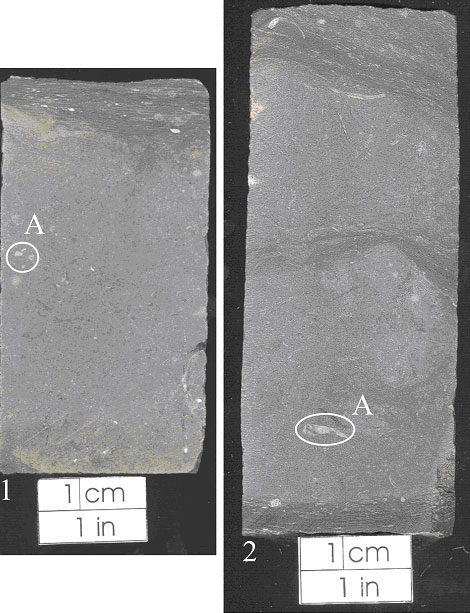 |
|
Kansas Geological Survey Open-file Report 2003-82 |
2.1.7 Bioclastic-Packstone-to-Grainstone Facies
Description
The bioclastic-packstone-to-grainstone limestone lithofacies is light to medium
gray. Diagnostic features of the lithofacies include medium bedding (10-30
cm), and well-preserved sparse marine bioclastic fragments (Figure 2.09).
Stylolites are distributed throughout the facies, while caliche and rhizoliths
are observed approaching the top of the facies. The dominant texture is packstone,
although a peloidal, non-fossiliferous grainstone may also present in the
facies. Identified fossils include disarticulated bryozoans, brachiopods,
crinoids and fusulinids. Trace fossils are sparse, however the facies appears
to be heavily bioturbated. Thickness of the bioclastic-packstone-to-grainstone
facies ranges from 5 to 30 feet thick (1.5 to 9 m). Contacts with the overlying
and underlying facies are gradational.
Paleoenvironmental Interpretation
Peloidal grains, the lack of abundant trace fossils, and disarticulation of
body fossils are evidence that the bioclastic-packstone-to-grainstone facies
was deposited in a high to moderate energy environment, probably above fair
weather wave base. Fragmentation of bioclasts is due to reworking by wave
or tidal processes in a relatively shallow-water environment and from extensive
bioturbation. Bryozoans, brachiopods, and crinoids indicate a normal salinity
marine environment (Heckel, 1972). Presence of caliche and rhizoliths in the
upper portion of the facies suggests post depositional alteration by pedogenic
processes. The combination of texture, peloidal grains, and fauna present
suggests that the bioclastic-packstone-to-grainstone was deposited in a relatively
normal marine, higher energy, and shallow environment. Historically, the bioclastic-packstone-to-grainstone
facies would be interpreted as part of the “upper limestone” in
the cyclothem model (Heckel, 1977).
 |
| Figure 2.09 - Polished core section of bioclastic packstone to grainstone facies comprised of marine fossil fragments (A). Sample 1 from 623' and sample 2 from 625' in the Hinthorn CW#1 well, 14-T32S-R16E, Montgomery County, Kansas |
e-mail : webadmin@kgs.ku.edu
Last updated December 2003
http://www.kgs.ku.edu/PRS/publication/2003/ofr2003-82/chapter2_7.html